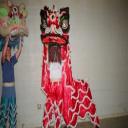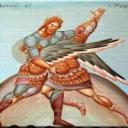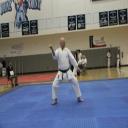Yahoo Answers is shutting down on May 4th, 2021 (Eastern Time) and beginning April 20th, 2021 (Eastern Time) the Yahoo Answers website will be in read-only mode. There will be no changes to other Yahoo properties or services, or your Yahoo account. You can find more information about the Yahoo Answers shutdown and how to download your data on this help page.
Trending News
What do you think is the purpose of this form's movement?
Consider this video for WTF Taekwondo's Taeguek 5 (Taeguek Oh Jang)
http://www.youtube.com/watch?v=APu5dDLg6Uc
The very last movement (0:45, and again 2:14) is a kick, hop, stomp, cat stance, and backfist - nearly all at the same time.
There are a few ways to analyze this movement, but the stance itself is most peculiar.
Why would the last movement of a form be in a stance that is nearly always transitive? There is little power to be assumed here, because of the poor stability, so, it stands to reason that the strike (the backfist) is merely a distraction and a segway to a counterclockwise turn and throw. And yet, that's the end of the form: no turn, no throw, only a strike that could barely be considered a "fight-ender" (a common explanation of this moment).
Consider that the previous set of movements is a front kick and a leap forwards into the backfist, landing a stomp in a cat stance. The backfist lands with the right hand, and the left hand pulls back to the waist.
Note also that the previous movement's front kick does not require the foot to return to the ground: front kick, hop, stomp, backfist, cat stance. This suggests to me that all of the movements here must be considered together as a unit.
And with this assumption, I wonder what possible application can be interpolated with a high front kick (where is the kicked person going to go?) then a stomp, and then - here's the real kicker - why is the left hand pulling back? What is it pulling back? Is there an assumption that the kick and stop leaves the opponent STILL hanging onto the arm, or is it that during the stomp you're somehow supposed to grab a hand for a pull? Or is it that (another common explanation) that the pull back is a "equal-and-opposite movement meant to accentuate (increase) the power of the backfist"?
Another oddity is that this movement - and only this movement - does not appear in the form except once. In other words, there's no symmetry. Why would that be?
Finally, note that the form is an intermediate-level form, designed for someone the equivalent of 3rd keup (kyu). So the application can't be too advanced or complicated.
I know what I'm told about this movement, and I know what I think about this movement; now I'm curious about what others think?
Thoughts?
Sorry Georgie - I believe all movements have direct martial relevance. When they don't, it's either because the student didn't understand the teacher, or the teacher taught incorrectly.
unfinished movements... yeah, I have a strong belief in that. the problem is here it is 30-odd years later, and still no one fixed it. so maybe there is another explanation?
cat/cross stance... it is a cross stance. some places call it a cat, others a cross.
leg lock... not in this case, the lead foot stomps, and the rear foot is behind the front unable to offer support to the lock. Also, the gymnastics to achieve the lock would make it too difficult and complicated to throw. I'm going with a different explanation. Also because of the jump, a punch isn't a plausible explanation for the pull back.
@liondancer - your explanation does seem plausible, but for a 3rd keup/kyu, this would be a feat indeed to be able to do. I'm interested in your sensei's thought on this.
@kokoro - agreed, but if the lead foot is stomping, how can it trap? Unless the stomp has a different purpose?
@pugpaws - it is rumored that our taeguek forms were created solely to distinguish from karate forms, and that applications are an afterthought. the techniques seen therein are also seen in karate, from this I derive all of my bunhae (bunkai). you will not find much bunkai in tkd forms, there is very little out there. That is why our forms have to be regarded with skepticism, because when you change forms for the sake of looks, and without regard to their original purpose, what's left is dubious. Nevertheless, I trust Dr Lee Kyu-Hyung (the older man seen in this video). He spent many years shaping WTF taekwondo, and regards the use of forms very highly.
@pakua82004 - can you please post an example of what you're saying?
@Georgie - thanks for the video. FYI, I've recently learned that the three techniques in a row is typically a strike, and has relevance to pressure points or vital areas. The assumption is that the first strike may not be effective enough, the second becomes more effective, and the third is the "nail in the coffin". The first two strikes in a succession of 3 or more is meant to prepare the area for the final one. As such, each must be aimed at precisely the same spot. If that doesn't happen, you need to try again, or find another technique.
@MAist25 - many people feel as you do. But that wouldn't explain the many similarities between tkd and karate: uniforms, belts, methods of teaching, hierarchy, forms, techniques, training. Of course, things in poomsae have been forsaken, but that doesn't make it right. We cannot hide from history - only ignore it. If this is truly the case, then why do forms at all? WTF requires forms for promotion, but they don't explain the concepts behind them. This would turn poomsae into the equivalent usefulness of an appendix or gall bladder: it's there, no one knows why, but we have to take care of it or we die.
11 Answers
- LiondancerLv 78 years agoFavorite Answer
We too have this move in Karate and here is how my Bunkai works. The moves do go together from the kick. Try the 'small stance' by wedging the rear leg against the calf of the front leg. The front leg has to be slightly bent and the motion is down to root not forward. Your 'front'/crossed leg should also feel pretty much wedged in place too. You should get a really solid stance that way so it is not a transition stance.
Now to the sequence. Kick, your opponent will go backwards, get there before your opponent has time to move his feet to catch up with his balance, you can grab his arm if he swings it to keep him from going backwards too fast, move up and place your foot halfway on top of his foot (you'll figure out how much with a little bit of practice so you don't lose your balance), bring your foot up and wedge it into place, deliver the back fist as explained in the video.
I love stepping on people's feet and often do it automatically just moving in. Everybody as soon as you get their feet, wants to back up or move their feet and looses their balance. I love it. There are a lot of foot techniques like that in Chinese martial art often wedging the big toe into pressure points on the top of the foot of your opponent. But even when you are wearing shoes the small bones in the foot break easily and a god placed 'stomp' can keep your opponent from following you when running away.
The stance has also been explained to me as a transition stance for a throw combining it with the next move, the turn and the backfist being a grab by the back of the neck (pressure points). It doesn't work really good for me but I have seen it done successfully too. In that case you do not step on your opponents toes either but merely use the forward momentum to get your opponents balance and you don't need to wedge your feet as much, just enough so you don't lose your balance.
There are stances in Aiki called Hito e mi (making the body small) that resemble this stance. They have purposes too but since I am really green in Aiki still, I only know of their existence but nothing detailed or when they are used. It's higher level stuff in our school. Let me ask Sensei and if he is in a good mood he may spill something and I'll get back with you on that.
Edit:
Here is what my teacher had to say about Hito e mi: In Japanese Martial arts these stances were developed in battle. Imagine walking in a line shoulder to shoulder. When confronting an opponent (also marching in a row) any step off not even an inch to the side was simply not possible yet you still had to be effective in your techniques. Getting off to the side would not only put you in the line of possibly two opponents (instead of just one) but also into the line of attack of the person fighting next to you so staying in your own line of attack was very important. Sometimes battles were very crowded and there was not a whole lot of room for big motions. For todays' application this situation can develop if you find yourself in a crowded room (bar) of have people with you to either side of you.
To answer your concern about pulling this off at 3rd kyu. In the beginning we only teach, (higher) kick, opponent goes backwards, moving in/after your opponent with the strike. Only in the higher ranks does it become more detailed. We often start students really early on more complicated techniques and are fully aware that they won't be able to pull them off as it takes a long time to get timing right. So if it takes 5 years to get a technique right and you introduce the technique early on then the student will be able to do it in maybe six or seven years. If you wait 5 years to introduce the technique, it will take the student another 5 years to learn this technique.
- KokoroLv 78 years ago
Cat stance, did I mis something it looked like a cross leg stance to me.
All stances are traditive.
The cross leg stance if that's what it is, can be used as a leg lock or break. It's not a week stance nor is the cat stance when done right it depends upon how you posture is.
I can't post it now from a phone but look up goju ryu tom hills cat stance or perhaps nako ashi dachi, he has good demo of body posturing on it.
As for why you are daring back your hand look about two movements before that if you interpret it as some one just punched and you redirected it and grabbed part of the arm, continuing with that if you don't let go you are still holding arm to the arm as you do the back fist striking the shoulder or the arm breaking the elbow
This is only one explanation I would have to play with this a little.
You might have to start teaching me these forms it will make it easier for me
Edit:> oops my bad it was an strike to the inside of the shoulder not a hammer fist, so you would be stretching the arm out until it pops or snaps.
Edit:>possum, that can still be a leg lock. That is the way it is done in many karate forms and the application is the same. Your lead foot traps the back part of your opponents leg and your rear leg locks it in place, done properly you can screw up the persons leg quite easily.
Edit:>
There are very few moves that don't have multiple applications, the example I have is just one of what I'm sure is many. All because I can't think of another doesn't mean there is only one.
I also agree with pugpaws, about the cross leg stance, it's almost like they are not committing to the movement or is lacking definition. So that might lead you to believe it's not for the purpose I suggested. But done properly with the appropriate power and commitment, it will work fine.
sorry possum i mis-understood.
the energy of the stomp goes inward and down. so in essences you are striking then sliding down on the leg, as you pin the leg with the back leg. at least that is the the way i perceive and perform it. the sliding down the leg is part of the stomp,
georgie, do you have a video of the form you are talking about.
i agree with possum all techniques in kata have application some are just not apparent.
thanks Georgie, I'll look at it over the weekend when i have a minute
Source(s): 30yrs ma - pugpaws2Lv 78 years ago
I too see no cat stance. I really have a problem with the way I see the crossed leg stance being done. Japanese and Okinawan stances are more distinct when done. I do not see any moves in any Kata that are fakes or distractions. Every move and transition should have at least one realistic use. I'll have to ponder this a while. In the mean time I will propose this. It is easy to assume that the cross stance and back fist are the end of the form. As I see it the turn back to the front after that is likely explained as a throw or takedown. (A throw if the turn back to the fornt is used along with the cross legged stance just before the turn.) Just something to keep in mind while looking at the form.
Edit: I decided to search the net and see what I could find as fa as explaining the moves in Taeguek Oh Jang. It surprised me (and yet I guess I shouldn't be) to find no videos of the form and its real breakdown uses. In fact I found no breakdowns of any Korean forms so far... Interesting to note, I did find a video of a Korean opening a bag of potato chips in a very unusual way, and a chick eating Chinese food while being pulled on a surf board. This leads me to wonder if my belief system on who knows what about the real applications of forms is right. Over the years (especially since the late 1970's) It would seem that the Okinawans have the most realistic bunkai for their Kata. While the Japanese have some on the same level it appears rare. As of today I have never seen or found anyone that does Korean arts that has close to the level the Okinawans break things down into. Seems that many people thing that forms are not much more than what you see is what you get. But one look into the breakdowns of Kata that Seiyu Oyata, Tony Annesi, and others have shows that forms do have very useful applications that are not easily discerned by just watching or doing Kata.
...
Source(s): Martial arts training over 46 years Teaching martial arts, over 39 years, since 1973 - pakua82004Lv 48 years ago
There is no 'cat stance', no stomping of legs, no leg lock, just a simple jump-in with a back fist to the face of the opponent. As said by some one, the Chinese MA has many of these jumps finishing with one leg behind the other which to the Northern stylist, it is called 'Yao-bu' (loosely translated as 'strange stance', and with a jump, Tiao Yao) or 'Tou-bu (stealing stance). Southern stylist, will call it 'Qi-lin mah' (qi-lin is a mystical animal, mah=stance). The major difference between TKD and CMA of this stance is the space between the two feet, and for CMA, the body is lower by bending the front leg, and not standing up. CMA's is wider, but the TKD instructor in the video did say that the distance should be about 2 feet which is the normal distance in the CMA's version even in tiao yao. As to why there is no follow-up after the jump-in back fist, the answer should come from the kata's originator. All katas are composed with a theme and a purpose, just like books.
- How do you think about the answers? You can sign in to vote the answer.
- MAist25Lv 48 years ago
It is because the WTF forms were not created with fighting applications in mind. Poomse are not to be studied the same way kata are. Kata has hidden techniques, TKD poomse does not. Poomse are simply a set of techniques strung together, with more advanced and difficult techniques as you progress through the ranks. Sorry to burst your bubble, but there are no hidden techniques/bunkai to be extracted from the taegeuk poomse...
This is due to the history of TKD and Karate. Much of the hidden techniques in Karate kata were removed by Gitchen Funakoshi and replaced with the simplified "block, punch, kick" methodology in order to teach Karate to kids and for lack of a better term, "mass produce" Karate as a sport/form of exercise. The original TKD masters learned the forms this way and were never taught bunkai or even understood the concept of bunkai or the true meaning of kata. Therefore, when they created TKD poomse, beginning with the palgwe, and 4 years later, the taegeuk poomse, bunkai or poomse applications were not even considered.
Poomse are more of an exercise that teaches technique, balance, proper stance, etc. as well as having a philosophical meaning which the TKD practitioner must try and capture through their performance of the poomse. It is an encyclopedia of the techniques within TKD. Do not try and compare poomse and kata; they are two very different things with different purposes.
Source(s): Taekwondo 3rd Dan - GeorgieLv 58 years ago
Very interesting question...I would like to see more questions like these...
Perhaps is not meant to be that much for a direct fighting application but to be more for training balance...
There is a move that is done three times, in the Biu Jee form of Wing Chun, that is not meant to have a direct fighting application as well...
Not all movements are necessary to have a direct fighting application, or at list an ideal fighting application...
Edit:
In addition is the obvious application that the opponent comes one step forward, so the practitioner is trained how to finish the move while is still in the transition process.
Possum: I am certain for the movement in the Biu Jee form of Wing Chun that is done three times, that has not a direct fighting application and is done for other purposes. I had crossed that. I don't know about Taekwondo though.
Kokoro: Is the move at 1.49-1.55 that is done three times in the following video...
- Karate DaveLv 68 years ago
I can't say if it was intended but I played with this a minute or two after class tonight, to my son's chagrin.
Try this, attacker grabs your right with his left in preparation to strike. The down "block becomes a strike to his wrist releasing his hold and turning him slightly. You grab his left with your left pulling it to the hip while executing the outside in "block" as an elbow lock bending them over, your front kick while not high is still to the face. The "hop" and back fist are a throw.
It would also work against a left handed mid level punch using the initial down block as a parry.
Like I said did not play long had a long drive home then taking my son to his mothers ( hour trip).
- TomLv 58 years ago
I guess I'm very spoiled in the Uechi Ryu world as to me most of these techniques/movements look weak and ineffective.
I agree that that crossed foot position would have to be for transition as if they were hit or tried to hit someone while in it they're going down.
I'm not a big fan of high kicks as they are easy to defend against and unless you do them extremely well and fast, they open you up to so many bad counter attacks. If I'm kicking someone it's to the knee or lower. Yes, high kicks are great for stretching and such, but they're just not something that I'd do, or that would be effective against someone that understands how to defend against them.
I love the way the overhead kicks look, but they're not effective for anything.
I did like their elbow strikes, those did look useful, and effective.
Source(s): 12 years of training in Uechi Ryu karate. - jwbulldogsLv 78 years ago
I believe that I have said this before. But I do not believe there was a bunkia for these forms. I do not believe the Koreans were taught the karate had hidden techniques. Then when they set off to create their own forms to separate what they were doing from karate they didn't have anything hidden. It was to be taken for face value. I can't prove this. but that is my belief.
I wish I could run into Master Shin. He came to the US in the 30's or 40's from korea. He would know more about this than I.
Source(s): Martial Arts since 1982 - SiFu frankLv 68 years ago
In a couple forms in Taekwando there is an unfinished move at the end. I have pondered this move in particular a lot and the only conclusion I can come to is that it is a transition move left unfinished to show balance.
Tae Guk has to do with harmony and balance of soft to hard. I have not found specific application in the encyclopedia.
Source(s): life











